The High-precision Transcontinental Traverse: Improving the Scale of the U.S. Survey Network
The Transcontinental Traverse, a survey that crisscrossed the entire contiguous United States along three east-west and five north-south corridors, was the most accurate large-area survey ever done prior to Global Positioning System surveys. This nationwide survey increased the accuracy of the existing U.S. survey network. It was also fundamental to the sophisticated mathematical readjustment of the nation's survey network known as the North American Datum of 1983.
- Introduction
- United States Survey Network
- Improving Distance Measurement
- Cape Canaveral Survey
- Designing a Survey Traverse
- The Trans-
continental Traverse - Conclusion
- Works Consulted
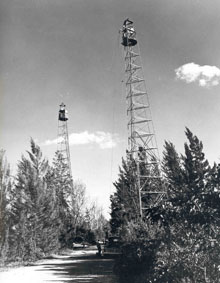
Twin towers used during the Transcontinental Traverse in 1962. The near tower shows the "gin poles," two horizontal beams just above the observing platform with ropes hanging from them, used to haul a heavy Geodimeter to the top of the tower. The far tower shows an observing tent in place.
The Transcontinental Traverse, commonly known as the “TCT,” grew out of smaller surveying projects that the U.S. Coast and Geodetic Survey (C&GS) conducted for the U.S. Air Force missile-tracking program in an area near Cape Canaveral, Florida, during the 1960s. C&GS developed unique specifications for this work that resulted in data that met or exceeded Air Force requirements. This led C&GS officials to conclude that applying the same specifications to a nationwide traverse, a surveying method, would dramatically improve the scale of the entire U.S. survey network. Soon after completing its work for the Air Force in Florida in 1961, C&GS embarked on the historic TCT, a 15-year survey traverse that spanned the nation.
Angle Measurement, Distance Measurement, and the United States’ Survey Network
The U.S. Coast and Geodetic Survey created the United States’ survey network by using the survey method called triangulation. In this method, surveyors establish a network of triangles and measure all the angles of adjacent and/or overlapping triangles in order to determine the positions of survey marks. To provide scale for this method, surveyors measure the length of a triangle’s side every sixth to twelfth triangle in the survey network. For the sides they do not physically measure, surveyors calculate length using trigonometry.
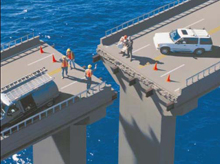
Survey-scale inaccuracy or positioning errors can lead to costly construction mistakes such as bridge misalignments. Click image for larger view and image credit.
From the earliest days of the C&GS, angles have been relatively easy to accurately measure using instruments called theodolites. Distances, however, have been very difficult to measure accurately, especially over long lines. This difficulty led to scale inaccuracy, the chief weakness of the nationwide triangulation network. If the scale is off, the distance between two survey points will be too long or too short and area measurements also will be incorrect. Therefore, anything constructed from these survey points, such as a bridge or a railroad, may not meet or align properly.
In geometry, even if the three angles of a triangle are measured perfectly, the lengths of its three sides can not be solved without knowing the length of at least one side. Since the lengths of most of the sides of the triangles in the survey network were computed through a series of triangles by using trigonometry and based on distances measured every sixth to twelfth triangle, small errors accumulated in the lengths of the sides of the triangles throughout the survey network.
Improving Distance Measurement

A Geodimeter, an electronic distance measuring instrument, revolutionized distance measurements and was the distance measuring device used in the TCT. Click image for larger view and complete caption.
Until the 1950s, C&GS made relatively slow forward progress conducting triangulation surveys, because these surveys covered wide areas and because of the time-consuming process of measuring distance. The sides of survey triangles varied from a few miles to about 175 miles (280 kilometers); most were 10 to 20 miles (16 to 32 kilometers) in length. Distance measurement techniques went through several improvements over time. However, the innovation that forever changed surveying and allowed the C&GS to make better progress was the development in the 1950s of an electronic distance measuring instrument (EDMI) that used a reflected beam of light to measure distance.
The C&GS tested some of the earliest models of the EDMI by comparing their distance measurements with those measured by the standard distance-measuring tool of the day: invar tapes. The tests yielded excellent results. In one comparison, distance measurements differed by only 0.25 inches (6 millimeters) in a line over 11 miles (18 kilometers) long. Besides being much faster than using invar tapes, the EDMI made it possible to measure lines that had been impossible to measure with tapes, such as lines across a river or a valley. EDMI sped up survey work and offered a solution to the network-scale-accuracy issue. Once it completed these tests, C&GS replaced invar tapes with EDMI for triangulation and traverse surveys.
Cape Canaveral Triangulation Survey Yields High-Precision Results
In 1960, the U.S. Air Force requested the survey of nine ballistic camera sites in the Cape Canaveral, Florida, area as a follow-up to earlier work done there by C&GS. The Air Force asked for a relative accuracy of one part in 400,000—four times the C&GS’s normal accuracy of one part in 100,000. Ballistic cameras use multiple exposures to record missile trajectories from a ground-level position; hence the need for exceptionally accurate and precise positioning from a surveyor’s point of view.
C&GS laid out an area triangulation scheme containing 63 survey stations and developed special procedures to help ensure the higher relative accuracy of the surveys. Using a Model 2 Geodimeter, a type of EDMI, surveyors measured 43 lines in the network. This was a much higher number of distance measurements than would be taken for a normal network triangulation survey, due to quicker and easier distance measurements enabled by EDMI. The results showed that the survey had a relative accuracy of one part in 1,000,000–two and one-half times the accuracy the Air Force had requested!
The Air Force then asked for more surveys to connect additional sites up to 250 miles (400 kilometers) from the Cape, requesting a relative accuracy of one part in 1,000,000 or better. Triangulation would not be practical for these greater distances because of the very wide area that would need to be surveyed.
Designing a High-Precision Survey Traverse
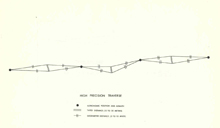
Initial design of the traverse for connecting U.S. Air Force survey sites 250 miles from Cape Canaveral. The C&GS initially used the same design for the TCT. Click image for larger view and complete caption.
C&GS officials designed a narrower, high-precision traverse that followed existing survey marks whenever possible to connect the sites for this larger area of the Southeast. The C&GS would later use the same initial design for the TCT.
A traverse is a series of survey points, placed in approximately a straight line for higher-precision surveys. In a traverse, surveyors measure the angles and distances between adjacent survey points. The measurements, often referred to as “observations,” can then be used to compute the positions of each of the survey points along the line of traverse.
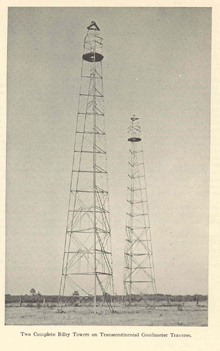
Twin Bilby Towers used during a portion of the TCT. The observations and measurements made from these towers provided extra checks on the TCT survey data. Click image for larger view.
The C&GS once again developed new and more rigorous specifications for this new survey with requirements to help ensure results of even higher quality than the previous survey near Cape Canaveral. The new specifications included strict checking tolerances for angle and distance measurements and also required that:
- All survey lines were at least 25 feet off the ground, requiring towers at all survey stations to ensure visibility between the survey points and to raise the line-of-sight sufficiently above ground level to help reduce errors in measuring angles caused by heat waves coming off the ground.
- An auxiliary survey station would be set at right angles to the long lines at every other survey station, adding redundancy to the traverse.
- All sides and all angles of all triangles would be measured multiple times on at least two occasions.
- The short distance between the main and auxiliary survey stations would be measured with invar tapes using precise procedures.
- Vertical angles were measured at both ends of the survey lines in order to provide elevation differences for lines measured by EDMI. For lines where the elevation difference was large, simultaneous vertical angles were observed in order to reduce the errors in measuring angles caused by refraction or bending of light waves. The C&GS conducted much of the TCT at night, to reduce the error in angle measurements caused by light refraction brought on by day-time heat.
- To help ensure accuracy, temperatures and humidity would be measured because they affect the speed of light used in measuring distance with the EDMI. Temperatures for some lines were measured mid-way along the line as well as at both ends. For a few lines, an aircraft with thermometers flew along the line at the same time the line was measured, to obtain temperature readings all along the lines.
Early results of these precise traverse surveys showed that they met the desired relative accuracy of one part in 1,000,000.
The Transcontinental Traverse
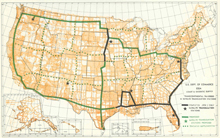
The status of completed (solid black lines) and planned (solid and dotted green lines) surveys for the TCT as of January 1, 1967. Click image for larger view and complete caption.
C&GS saw immediately that extending this type of traverse survey across the continent would solve the scale issues within the national survey network. C&GS then expanded the methods used to connect the Florida surveys into a nationwide effort called the High-precision Transcontinental Traverse, or “TCT.”
In late 1967, C&GS modified the Geodimeters used to measure distance in the TCT by replacing mercury vapor lights with lasers. This replacement allowed surveyors to measure longer lines with the same accuracy. C&GS changed the design of the traverse to reflect the use of lasers, thereby reducing the number of survey observations required and eliminating the need to construct many survey towers.
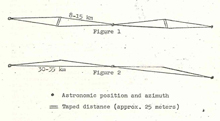
The original design of the TCT (top), the first modified design (middle), and the second modified design – a single-line traverse (bottom). Click image for larger view.
Later, C&GS modified the design of the TCT a second time, now to a single-line traverse. In a single-line traverse, there are single distance and angle measurements between each pair of adjacent survey points, with no “twin” point nearby and no overlapping distance and direction observations as there were in the two earlier TCT designs. This modification simplified the observations required for the TCT yet again. Fewer observations over longer lines in this second TCT design modification yielded a network that was highly accurate and a savings in time and money.
Completed in 1976, the TCT had an accuracy of one part in 1,000,000, the most accurate ever for a survey covering a large area using classical (non-Global Positioning System) methods. The TCT was integral to the redefinition and readjustment of the horizontal network, the North American Datum of 1983.
Just the name “Transcontinental Traverse” is imposing and suggests an effort of monumental proportions. And indeed it was: The TCT included over 2,700 survey stations, covered over 13,600 miles, and passed through 44 states. Despite these monumental efforts, the TCT took only 15 years to complete!
Conclusion
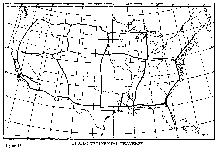
The final routes of the Transcontinental Traverse. Click image for larger view.
The Transcontinental Traverse was the most precise large-area survey ever done up to the time it was completed in 1976. Beginning with surveys of areas around Cape Canaveral, Florida, conducted at the request of the U.S. Air Force, the U.S. Coast and Geodetic Survey developed extraordinary survey specifications and criteria to meet Air Force accuracy requirements. Thanks to a new level of rigor and the development of improved distance measuring technology known as the electronic distance measuring instrument, these surveys produced results that met or far exceeded expectations.
Realizing that these techniques could be used on a national scale, C&GS applied them to a Transcontinental Traverse, a coast-to-coast survey of the United States that greatly improved the accuracy and precision of the U.S. survey network, a vital element of the nation’s commerce and transportation infrastructure.
Contributed by Commander George E. Leigh, NOAA Corps, (Ret'd.)
Works Consulted
Meade, B.K. (1974). High-Precision Distance Measurements in the United States. International Symposium on Terrestrial Electromagnetic Distance Measurements and Atmospheric Effects on Angular Measurements. August, 1974.
Meade, B.K. (1968). High-Precision Geodimeter Traverse Surveys in the United States. International Association of Geodesy. December 1968.
Meade, B.K. (1967). Progress and Results of High-Precision Traverse Surveys. American Society of Photogrammetry. March, 1967.
Meade, B.K. (1966). High-Precision Transcontinental Traverse Surveys. American Congress on Surveying and Mapping. March 10, 1966.
Schwartz, C.R. (1989). North American Datum of 1983. National Oceanic and Atmospheric Administration. December, 1989.
Simmons, L. G. (1960). A Singular Geodetic Survey. U.S. Coast and Geodetic Survey. September, 1960.
Smithsonian Institution. EDM (Geodimeter Model 4B). Physical
Sciences Collection – Surveying and Geodesy. National Museum
of American History Web Site. Retrieved July 2, 2007, from: http://americanhistory.si.edu/collections/surveying/
object.cfm?recordnumber=758694
